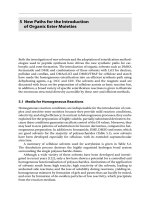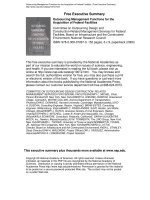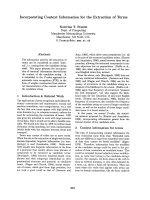New Imperatives for the Elements of Investing_4 pdf
Bạn đang xem bản rút gọn của tài liệu. Xem và tải ngay bản đầy đủ của tài liệu tại đây (294.01 KB, 18 trang )
67
Diversify
if the stock market falls sharply and bonds rise in price,
as was the experience of investors in 2008? What do you
do then?
The correct response is to make corrective changes
in the mix of your portfolio. This is what we mean by
“ rebalancing. ” It involves not letting the asset propor-
tions in your portfolio stray too far from the ideal mix
you have chosen as best for you. Suppose the equity por-
tion of your portfolio is too high. You could direct all
new allocations, as well as the dividends paid from your
equity investments, into bond investments. (If the bal-
ance is severely out of whack, you can shift some of your
money from the equity fund you hold into bond invest-
ments.) If the proportion of your investments in bonds
has risen so that it exceeds your desired allocation, you
can move money into equities.
The right response to a fall in the price of one asset
class is never to panic and sell out. Rather, you need
the long - term discipline and personal fortitude to buy
more. Remember: The lower stock prices go, the bet-
ter the bargains if you are truly a long - term investor.
Sharp market declines may make rebalancing appear a
frustrating “ way to lose even more money. ” But in the
c03.indd 67c03.indd 67 11/3/09 9:41:48 AM11/3/09 9:41:48 AM
68
The Elements of Investing
long run, investors who rebalance their portfolios in a
disciplined way are well rewarded.
When markets are very volatile, rebalancing can actu-
ally increase your rate of return and, at the same time,
decrease your risk by reducing the volatility of your
portfolio.
The decade from 1996 through 2005 provides an excel-
lent example. Suppose an investor ’ s chosen allocation is
60 percent in stocks and 40 percent in bonds. Let ’ s use
a broad - based U.S. total stock market index fund for the
equity portion of the portfolio and a total bond market
index fund for the bonds to illustrate the advantages of
rebalancing. The table on page 69 shows how rebalancing
was able to increase the investor ’ s return while reducing
risk, as measured by the quarterly volatility of return.
If an investor had simply bought such a 60/40 port-
folio at the start of the period and held on for 10 years,
she would have earned an average rate of return of 8.08
percent per year. But if each year she rebalanced the port-
folio to preserve the 60/40 mix, the return would have
increased to almost 8 ½ percent. Moreover, the quarterly
results would have been more stable, allowing the inves-
tor to sleep better at night.
c03.indd 68c03.indd 68 11/3/09 9:41:48 AM11/3/09 9:41:48 AM
69
Diversify
During the decade January 1996 through December
2005, an annually rebalanced portfolio provided lower
volatility and higher return.
The Importance of Rebalancing
P ortfolio :
a
60% T otal S tock
M arket
40% T otal B ond
M arket
A verage A nnual
R eturn
R isk
(Volatility)
b
Annually rebalanced 8.46% 9.28
Never rebalanced 8.08% 10.05
a
Stocks represented by a Russell 3000
®
total stock market
fund. Bonds represented by a Lehman U.S. aggregate total
bond market fund.
b
The variation of your portfolio ’ s annual return as measured
by the standard deviation of return.
Why did rebalancing work so well? Suppose the inves-
tor rebalanced once a year at the beginning of January.
(Don ’ t be trigger - happy: Rebalance once a year.) During
January 2000, near the top of the Internet craze, the
stock portion of the portfolio rose well above 60 percent,
c03.indd 69c03.indd 69 11/3/09 9:41:49 AM11/3/09 9:41:49 AM
70
The Elements of Investing
so some stocks were sold and the proceeds put into
bonds that had been falling in price as interest rates
rose. The investor did not know we were near a stock
market peak (the actual peak was in March 2000).
But she was able to lighten up on stocks when they
were selling at very high prices. When the rebalancing
was done in January 2003, the situation was different.
Stocks had fallen sharply (the low of the market occurred
in October 2002) and bonds had risen in price as interest
rates were reduced by the Federal Reserve. So money was
taken from the bond part of the portfolio and invested in
equities at what turned out to be quite favorable prices.
Rebalancing will not always increase returns. But it
will always reduce the riskiness of the portfolio and
it will always ensure that your actual allocation stays
consistent with the right allocation for your needs and
temperament.
Rebalancing will not always increase returns.
But it will always reduce the riskiness of the
portfolio and it will always ensure that your
actual allocation stays consistent with the right
allocation for your needs and temperament.
c03.indd 70c03.indd 70 11/3/09 9:41:49 AM11/3/09 9:41:49 AM
71
Diversify
Investors will also want to consider rebalancing to
change their portfolio ’s asset mix as they age. For most
people, a more and more conservative asset mix that has
a deliberately reduced equity component will provide less
stress as they approach and then enter retirement.
c03.indd 71c03.indd 71 11/3/09 9:41:49 AM11/3/09 9:41:49 AM
c03.indd 72c03.indd 72 11/3/09 9:41:49 AM11/3/09 9:41:49 AM
73
I V
AVOID BLUNDERS
Y ou, far more than the market or the economy, are the
most important factor in your long - term investment
success.
We ’ re both in our seventies. So is America ’ s favorite
investor, Warren Buffett. The main difference between
his spectacular results and our good results is not the
economy and not the market, but the man from Omaha.
He is simply a better investor than just about any other
c04.indd 73c04.indd 73 10/31/09 1:37:01 PM10/31/09 1:37:01 PM
74
The Elements of Investing
investor in the world, amateur or professional. Brilliant,
consistently rational, and blessed with a superb mind for
business, he concentrates more time and effort on being a
better investor and is more disciplined.
One of the major reasons for Buffett ’ s success is that
he has managed to avoid the major mistakes that have
crushed so many portfolios. Let ’ s look at two examples.
In early 2000, many observers declared that Buffett
had somehow lost his touch. His Berkshire Hathaway
portfolio had underperformed the popular high-tech
funds that enjoyed spectacular returns by loading up
on stocks of technology companies and Internet start -
ups. Buffett avoided all tech stocks. He told his inves-
tors that he refused to invest in any company whose
business he did not fully understand — and he didn ’ t
claim to understand the complicated, fast - changing
technology business — or where he could not fi gure
out how the business model would sustain a growing
stream of earnings. Some said he was pass é , a fuddy -
duddy. Buffett had the last laugh when Internet - related
stocks came crashing back to earth.
In 2005 and 2006, Buffett largely avoided the popular
complex mortgage - backed securities and the derivatives
that found their way into many investment portfolios.
c04.indd 74c04.indd 74 10/31/09 1:37:01 PM10/31/09 1:37:01 PM
75
Avoid Blunders
Again, his view was that they were too complex and
opaque. He called them “ fi nancial weapons of mass
destruction. ” When in 2007 they brought down many
a fi nancial institution (and ravaged our entire fi nancial
system), Berkshire Hathaway avoided the worst of the
fi nancial meltdown.
Avoiding serious trouble, particularly troubles that
come from incurring unnecessary risks, is one of the
great secrets to investment success. Investors all too often
beat themselves by making serious — and completely
unnecessary — investment mistakes. In this chapter, we
highlight the common investment mistakes that can
prevent you from realizing your goals.
As in so many human endeavors, the
secrets to success are patience,
persistence, and minimizing mistakes.
As in so many human endeavors, the secrets to success
are patience, persistence, and minimizing mistakes. In driv-
ing, it ’ s having no serious accidents; in tennis, the key is
getting the ball back; and in investing, it ’ s indexing — to
avoid the expenses and mistakes that do so much harm
to so many investors.
c04.indd 75c04.indd 75 10/31/09 1:37:01 PM10/31/09 1:37:01 PM
76
The Elements of Investing
OVERCONFIDENCE
In recent years, a group of behavioral psychologists and
fi nancial economists have created the important new fi eld
of behavioral fi nance. Their research shows that we are not
always rational and that in investing, we are often our worst
enemies. We tend to be overconfi dent, harbor illusions of
control, and get stampeded by the crowd. To be forewarned
is to be forearmed.
At our two favorite universities, Yale and Princeton,
psychologists are fond of giving students questionnaires
asking how they compare with their classmates in respect
to different skills. For example, students are asked: “ Are
you a more skillful driver than your average classmate? ”
Invariably, the overwhelming majority answer that they
are above - average drivers compared with their classmates.
Even when asked about their athletic ability, where one
would think it was more diffi cult to delude oneself, stu-
dents generally think of themselves as above - average ath-
letes, and they see themselves as above-average dancers,
conservationists, friends, and so on.
And so it is with investing. If we do make a success-
ful investment, we confuse luck with skill. It was easy in
early 2000 to delude yourself that you were an investment
c04.indd 76c04.indd 76 10/31/09 1:37:01 PM10/31/09 1:37:01 PM
77
Avoid Blunders
genius when your Internet stock doubled and then
doubled again. The fi rst step in dealing with the perni-
cious effects of overconfi dence is to recognize how per-
vasive it is. In amateur tennis, the player who steadily
returns the ball, with no fancy shots, is usually the player
who wins. Similarly, the buy - and - hold investor who
prudently holds a diversifi ed portfolio of low - cost index
funds through thick and thin is the investor most likely
to achieve her long - term investment goals.
Investors should avoid any urge to forecast the stock
market. Forecasts, even forecasts by recognized “ experts, ”
are unlikely to be better than random guesses. “ It will
fl uctuate, ” declared J. P. Morgan when asked about his
expectation for the stock market. He was right. All other
market forecasts — usually estimating the overall direc-
tion of the stock market — are historically about 50 per-
cent right and 50 percent wrong. You wouldn ’ t bet much
money on a coin toss, so don ’ t even think of acting on
stock market forecasts.
Why? Forecasts of many “ real economy ” develop-
ments based on hard data are wonderfully useful. So are
weather forecasts. Market forecasting is many times more
diffi cult. Market forecasts have a poor record because
the market is already the aggregate result of many, many
c04.indd 77c04.indd 77 10/31/09 1:37:01 PM10/31/09 1:37:01 PM
78
The Elements of Investing
well - informed investors making their best estimates and
expressing their views with real money. Predicting the
stock market is really predicting how other investors will
change the estimates they are now making with all their
best efforts. This means that, for a market forecaster to
be right, the consensus of all others must be wrong and
the forecaster must determine in which direction — up or
down — the market will be moved by changes in the con-
sensus of those same active investors.
Warning: As human beings, we like to be told what
the future will bring. Soothsayers and astrologists have
made forecasts throughout history. A panoply of genial
myths have been part of the human experience for
centuries — and we ’ re all still human. Buildings don ’ t
have a 13th fl oor; we avoid walking under ladders, toss
salt over our shoulders, and don ’ t step on cracks in the
sidewalk. “ Que sera, sera ” has charm as a tune, but it
gives no real satisfaction.
The largest, longest study of experts ’ economic fore-
casts was performed by Philip Tetlock, a professor at the
Haas Business School of the University of California –
Berkeley. He studied 82,000 predictions over 25 years by
300 selected experts. Tetlock concludes that expert pre-
dictions barely beat random guesses. Ironically, the more
c04.indd 78c04.indd 78 10/31/09 1:37:01 PM10/31/09 1:37:01 PM
79
Avoid Blunders
famous the expert, the less accurate his or her predictions
tended to be.
So, as an investor, what should you do about
forecasts — forecasts of the stock market, forecasts of inter-
est rates, forecasts of the economy? Answer: Nothing.
You can save time, anxiety, and money by ignoring all
market forecasts.
As an investor, what should you do about
forecasts — forecasts of the stock market,
forecasts of interest rates, forecasts of the econ-
omy? Answer: Nothing. You can save time, anxi-
ety, and money by ignoring all market forecasts.
BEWARE OF MR. MARKET
As people, we feel safety in numbers. Investors tend to get
more and more optimistic, and unknowingly take greater
and greater risks, during bull markets and periods of
euphoria. That is why speculative bubbles feed on them-
selves. But any investment that has become a widespread
topic of conversation among friends or has been hyped
by the media is very likely to be unsuccessful.
c04.indd 79c04.indd 79 10/31/09 1:37:01 PM10/31/09 1:37:01 PM
80
The Elements of Investing
Throughout history, some of the worst investment mis-
takes have been made by people who have been swept up in
a speculative bubble. Whether with tulip bulbs in Holland
during the 1630s, real estate in Japan during the 1980s, or
Internet stocks in the United States during the late 1990s,
following the herd — believing “ this time it ’ s different ” — -
has led people to make some of the worst investment mis-
takes. Just as contagious euphoria leads investors to take
greater and greater risks, the same self - destructive behavior
leads many investors to throw in the towel and sell out
near the market ’ s bottom when pessimism is rampant and
seems most convincing.
One of the most important lessons you can learn about
investing is to avoid following the herd and getting caught
up in market - based overconfi dence or discouragement.
Beware of “ Mr. Market. ”
First described by Benjamin Graham, the father of
investment analysis, two mythical characters compete for
our attention as investors. * One is Mr. Market and one is
Mr. Value. Mr. Value invents, manufactures, and sells all
*
Benjamin Graham (with Jason Zweig), The Intelligent Investor
(New York: HarperBusiness, 2003).
c04.indd 80c04.indd 80 10/31/09 1:37:01 PM10/31/09 1:37:01 PM
81
Avoid Blunders
the many goods and services we all need. Working hard at
repetitive and often boring tasks, conscientious Mr. Value
beavers away day and night making our complex economy
perform millions of important functions day after day.
He ’ s seldom exciting, but we know we can count on him
to do his best to meet our wants.
While Mr. Value does all the work, Mr. Market has
all the fun. Mr. Market has two malicious objectives.
The fi rst is to trick investors into selling stocks or mutual
funds at or near the market bottom. The second is to
trick investors into buying stocks or mutual funds at or
near the top. Mr. Market tries to trick us into changing
our investments at the wrong time — and he ’ s really good
at it. Sometimes terrifying, sometimes gently charming,
sometimes compellingly positive, sometimes compel-
ling negative, but always engaging, this malicious, high-
maintenance economic gigolo has only one objective:
to cause you to do something. Make changes, buy or
sell — anything will do if you ’ ll just do something. And
then do something else. The more you do, the merrier
he will be.
Mr. Market is expensive and the cost of transac-
tions is the small part of the total cost. The large part of
the total cost comes from the mistakes he tricks us into
c04.indd 81c04.indd 81 10/31/09 1:37:01 PM10/31/09 1:37:01 PM
82
The Elements of Investing
making — buying high and selling low. Look at the crafty
devil ’ s record of success. Here ’ s how he has been tricking
investors as a whole. In the next fi gure we superimpose
the fl ows of money going into equity mutual funds
against the general level of market prices. The lesson is
unmistakable. Money fl ows into the funds when prices
are high. Investors pour money into equity mutual
funds at exactly the wrong time.
More money went into equity mutual funds dur-
ing the fourth quarter of 1999 and the fi rst quarter of
2000 — just at the top of the market — than ever before.
And most of the money that went into the market
was directed to the high technology and Internet
funds — the stocks that turned out to be the most
overpriced and then declined the most during the
subsequent bear market. And more money went out
of the market during the third quarter of 2002
than ever before, as mutual funds were redeemed or
liquidated — just at the market trough. Note also that
during the punishing bear market of 2007 – 2008, new
record withdrawals were made by investors who threw
in the towel and sold their mutual fund shares — at
record lows — just before the fi rst, and often best, part
of a market recovery.
c04.indd 82c04.indd 82 10/31/09 1:37:01 PM10/31/09 1:37:01 PM
83
Avoid Blunders
It ’ s not today ’ s price or even next year ’ s price that
matters; it ’ s the price you ’ ll get when it ’ s your time to sell
to provide spending money during your years of retire-
ment. For most investors, retirement is a long way off
in the future. Indeed, when pessimism is rampant and
market prices are down is the worst time to sell out or to
stop making regular investment contributions. The time
to buy is when stocks are on sale.
Investing is like raising teenagers — “ interesting ” along
the way as they grow into fi ne adults. Experienced par-
ents know to focus on the long term, not the dramatic
daily dust - ups. The same applies to investing. Don ’ t let
150,000
Net New Cash Flow (left axis)
S&P 500 (right axis)
100,000
1800
1100
800
400
50,000
0
Ϫ50,000
⍀1°90
⍀4°90
⍀3°91
⍀2°92
⍀1°93
⍀4°93
⍀3°94
⍀2°95
⍀1°96
⍀4°96
⍀2°97
⍀1°99
⍀4°99
⍀3°00
⍀3°00
⍀3°00
⍀2°01
⍀1°02
⍀4°02
⍀3°03
⍀2°04
⍀1°05
⍀4°05
⍀3°06
⍀2°07
⍀1°06
⍀4°09
Ϫ100,000
Ϫ150,000
Cash Flow to Equity Funds Follows the Stock Market
Source: The Vanguard Group.
c04.indd 83c04.indd 83 10/31/09 1:37:01 PM10/31/09 1:37:01 PM
84
The Elements of Investing
Mr. Market trick you into either exuberance or distress.
Just as you do when the weather is really extreme, remem-
ber the ancient counsel, “ This too shall pass. ”
You don ’ t care if it ’ s cold and raining or warm and
sunny 10,000 miles away because it ’ s not your weather.
The same detachment should apply to your 401(k)
investments until you approach retirement. Even at age
60, chances are you will live another 25 years and your
spouse may live several years more.
THE PENALTY OF TIMING
Does the timing penalty — the cost of second - guessing
the market — make a big difference? You bet it does. The
stock market as a whole has delivered an average rate of
return of about 9 ½ percent over long periods of time.
But that return only measures what a buy - and - hold
investor would earn by putting money in at the start of the
period and keeping her money invested through thick
and thin. In fact, the returns actually earned by the aver-
age investor are at least two percentage points — almost
one - fourth — lower because the money tends to come in
at or near the top and out at or near the bottom. *
*
Ilia D. Dichev, “What Are Stock Investors’ Actual Historical Returns?”
American Economic Review 97 (March 2007): 386–401.
c04.indd 84c04.indd 84 10/31/09 1:37:01 PM10/31/09 1:37:01 PM









